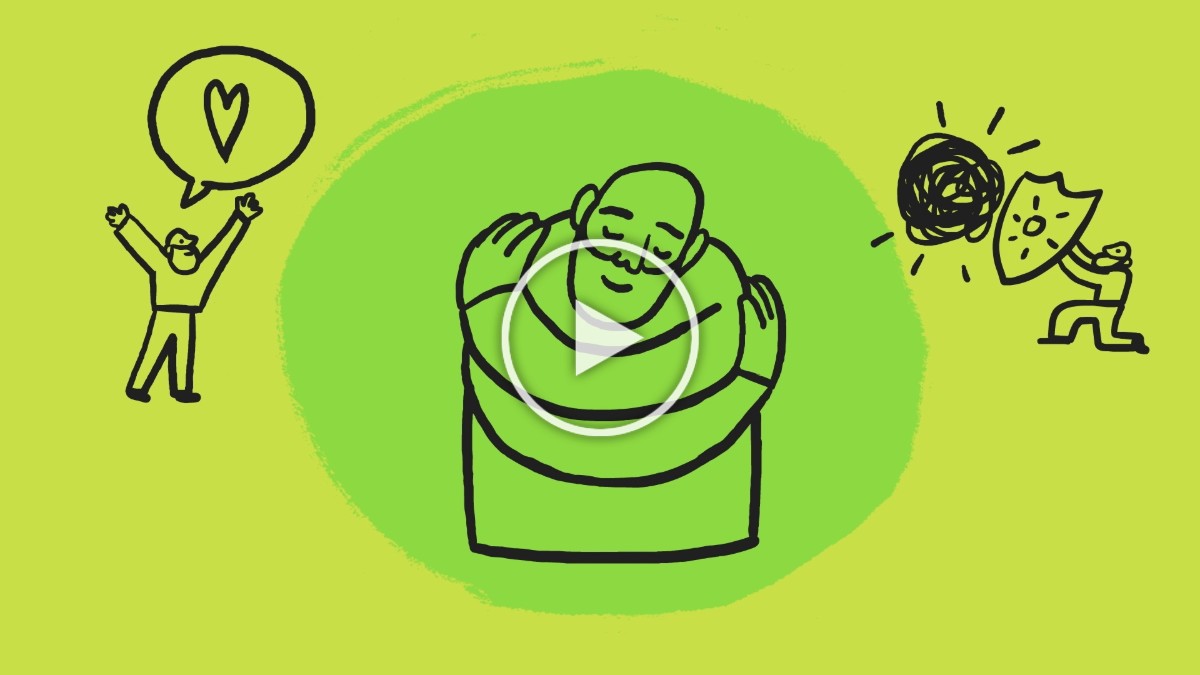Acceptance
Be comfortable with who you are
No one is perfect, yet we often expect ourselves to be! When we learn to accept ourselves we are likely to be happier and better at learning and growing!
How we feel about ourselves can have a big influence on how happy and resilient we are. Accepting that, like all human beings, we have strengths and imperfections, we’ll make mistakes and sometimes fail is an important component of psychological wellbeing [1]. It doesn’t mean we won’t feel bad when we mess up, but we don’t dwell on it as much or beat ourselves up about it. This means we are more able to learn and grow and move on. We are also less likely to feel ashamed and withdraw from others, and it can boost our relationships and compassion towards others [2].
The good news is research shows we can learn how to accept ourselves more [3]. Developing the skills of self-compassion, a better understanding our strengths, how to use these more, and ways to work with or around our weaknesses can all positively impact our happiness.
This may be even more important now than ever before. Social media makes it very easy to compare how we feel inside about ourselves to how we perceive other people and their lives from the outside. Yet most of us only post the best images of ourselves online. We may even feel we have to edit or filter our photos to make us look how we think we should rather than how we actually are. We seek others’ "likes" to validate the images we’ve posted and feel bad about ourselves if we don't get enough of these. This can affect us at any age but can be especially damaging when we’re young.
Being more able to know and accept our whole self, to be real rather than trying to be perfect, is a firmer foundation for a happier life at any age.
Why not take action right now? Join Abi, our coach from the 10 Days of Happiness program, for a short video and a quick activity to help you move towards self-acceptance.
Self-acceptance vs. self-esteem
Both self-acceptance and self-esteem are generally positively associated with psychological wellbeing [4], however there are differences between these, especially when it comes to how we pursue them [5].
Self-acceptance is an awareness of both the positive and negative aspects of our self, while maintaining an attitude of positive regard [6]. It’s been associated with reduction in psychological ill-health and is integral to wellbeing [7]. Albert Ellis, a renowned psychologist, described two choices: accepting ourselves conditionally (i.e., only under certain conditions, for example when we succeed) or unconditionally (under all circumstances). The first choice he proposed is harmful. If we don’t fulfil the conditions we set our self and fail, we think we are a loser or ‘good for nothing’ rather than accepting failing as a normal part of life and learning from it [8]. When we accept ourselves unconditionally, we recognise that there will be times we perform well but we’ll also make mistakes and sometimes fail. Acceptance involves acknowledging the “unvarnished facts” of ourselves and our situation – the good and the not so good, without judging ourselves. Rather than this causing us to be stuck with things as they are, acceptance is the foundation for growth and change [9].
Self-esteem is our sense of value or worth. It is based on judgement about how good we are in specific areas of our lives (e.g. performance at school, work or in sport or in relationships) or relative to other people. As it can be dependent on our judgements about success or failure or on comparison to others it can be fragile [10].
The pursuit of self-esteem can lead us to overly focus on, or inflate, the positive aspects of ourselves and our performance and ignore or hide areas we don't feel good about. Our need for high self-esteem, to feel good about ourselves in this way, can make it harder for us to seek and accept negative feedback, even if this is constructive, so making self-improvement more difficult. It can also cause us to feel angry or defensive when our self-esteem us threatened.
One practical way we can develop self-acceptance is through learning to be self-compassionate [11].


Do you have inner critic or an inner wise, kind friend?
Think about a friend messing up or failing at something. What would you say to them and how would you say it? Now think about yourself making a similar mistake or failing in that way. What would you say to yourself and how would you say it? Is there a difference? In which situation are you more likely to be tougher?
Many of us are harsher on ourselves than we are to others [12]. Often MUCH harsher. Whilst this inner critic usually wants us to be the best we can, it can have the opposite effect, undermining our ability to perform and makes us overly fear failure. An overly critical inner voice activates the threat system in our primitive emotional brain. This causes us to feel emotions like fear and shame, which in turn can make us less able to improve and grow! [13]
Cultivating an inner voice that is more like a wise, kind and helpful friend can help us to feel happier, more confident, less stress and better able to develop ourselves. It’s not about ignoring our mistakes but finding constructive ways to learn and move forward!
Try it: What would a wise, kind and helpful friend say to you when you mess up or fall short of your own expectations? How would they say it? How will you remember this the next time you make a mistake or fail?
For example: A kind neutral observer might say: “When you were late with that report I could see you felt a bit stupid and embarrassed. You worried what others might think of you. That must have been unpleasant and difficult for you. Remember you weren’t late on purpose. Other people have been late too and will be in the future. It can happen to anyone.”
Now reflect on what can you learn to do next time?
What is self-compassion?
Cultivating a kinder, more constructive inner voice is part of learning to be more self-compassionate. Compassion isn’t something that only applies to how we respond to others when they are struggling, we can be compassionate towards ourselves. Compassion means acknowledging the suffering and being motivated to help alleviate or prevent it.
Dr. Kristen Neff, one of the world’s leading experts in the topic, has identified three key components which combined enable self-compassion:
1. Kindness rather than judgement – messing up, failing or struggling is part of life and of course doesn’t feel good. Rather than beating ourselves up for not being good enough, when we are self-compassionate, we are warm and understanding towards ourselves like we would be to a good friend.
2. Mindful awareness – this means honestly acknowledging our shortcomings, mistakes, struggles and the difficult unpleasant emotions associated with these but not getting caught up or stuck in them.
3. Common humanity – when we feel inadequate or ashamed, it can be very isolating. It can feel like we’re the only one that messes up. This can cause us to want to hide all or part of ourselves or disconnect from others. An important part of self-compassion is recognising that ALL human beings make mistakes, fail sometimes and are imperfect. It’s normal! Reminding ourselves of this can help to reduce difficult emotions and enables us to feel part of a shared human experience rather than alone [14].
Self-compassion is not being soft on ourselves, it allows us to look at what we need to improve and work on rather than feel ashamed or avoidant, so helps us grow and develop. Self-compassion is associated with happiness, optimism and life satisfaction, increased motivation, positive body image and taking care of our health [15]. It is also associated with reduced risk of depression and anxiety, reduced stress and perfectionism and benefit our connections with others. Self-compassion during major life difficulties supports resilience and higher psychological wellbeing [16].
Self-compassion also benefits our connections with others, making us more able to see others’ perspective, more likely to forgive and be kind [17]. It also seems to help us accept others’ limitations and mistakes too [18].
Try it: Think about a recent time you messed up or felt inadequate and the difficult emotions you felt as a result. Now practice a self-compassionate approach in your mind or by writing yourself a letter. In a kind way, as if you were a kind compassionate neutral observer, express acknowledgement and understanding of the situation and how you felt, list the specific difficult emotions. Think about the ways other people might have done or experienced something similar. Express caring, not judgement. Notice how this feels.


The benefits of playing to your strengths
As human beings, we have a natural negativity bias – a tendency to focus on what’s wrong and interpret ambiguous information negatively and this can extend to what we focus on in our self. Many of us give more attention and weight to what we’re not good at than we give to what we do well or effortlessly. Yet all of us have a mix of strengths and weaknesses.
We can think of strengths in different ways, for example, talents (our natural abilities or intelligence), skills or competencies that we’ve developed and learned, our interests (passions), our values and external resources we can draw on. [19]
One of the most studied forms of strength is what is known as ‘character strength’. Positive personality traits that reflect our basic identity, produce positive outcomes for ourselves and others and contribute to the collective good. [20] Indeed it has been said that good character is not the absence of deficits, rather is a family of positive characteristics. [21]
The most widely applied model of character strengths is known as the VIA. Formerly this stood for ‘values in action’ but is now taken to represent a pathway to wellbeing and other positive outcomes. The VIA was developed to provide an inventory of what is best in human beings. It comprises 24 strengths that were found to be universal across different cultures and history. The VIA survey of these strengths is free (see below), has been taken by millions of people around the world and is available in many different languages.
Dr Ryan Neimeic, one of the leading experts in VIA character strengths, defines these as ways of behaving, thinking or feeling that we have a natural capacity for, enjoy doing, and which enable us to perform well [22]. Our character strengths can be the driving force behind making the most of our talents, passions and other resources. For example, we may have a naturally good singing voice, but applying the character strength of perseverance will help us make the most of that talent and develop the skills we need to become a great singer.
Taking a strengths focus doesn’t mean ignoring our weaknesses but rather keeping these in perspective and finding ways we can work with or around them. In fact, once we have an understanding of our strengths we can use these to help us develop, manage or mitigate our weaker areas or even reframe them constructively.
Over the last twenty years or so research has shown that there are wellbeing and other benefits that come from becoming aware of our strengths and finding ways to use them more. In a classic, replicated study, identifying our top character strengths and choosing one to use in new ways for a week was found to increase happiness and reduce unhappiness for up to six months [23]!
Studies show that understanding and putting our strengths into practice can have a wide range of potential benefits including feeling happier, more confident, and less stressed, boosting energy and resilience, boosting our relationships with others and being better at developing ourselves. People who apply their strengths were found to be more likely to achieve goals, be more engaged and perform better at work or school. [24]
Try it: Think back over the past week. Identify examples of you using your strengths. Think of times when you both functioned well and felt good – enjoying what you were doing. Whether that’s at home, during your leisure time, at work, college or school; alone or with others. Now pick one of the strengths you used last week and think of how you might use it in the week ahead. Where and when will you do that?
Becoming aware of your signature strengths
We will have our own unique constellation and draw on these to different degrees and in different combinations depending on the situation or context. However, some strengths will be more ‘us’ than others. These are known as our ‘signature strengths'.
Our signature strengths are central to us and have three key features. They are:
- ‘Essential’ or best reflect our core self
- ‘Energising’ – using these strengths feels uplifting and energising
- ‘Effortless’ – using them feels natural and tends to come easy to us [25]
Try it: Here's a simple way to identify your signature strengths.
1. First take a moment to reflect right now – what do you think and feel are your top 3- 5 character strengths? You might find it helpful to review the list of VIA 24 character strengths as you do this.
2. Now, if you can, try taking the free VIA survey. It will take 10-15 minutes, You’ll get a ranking of all 24 strengths listed in their relative strength for you. Typically your top five or so will be your signature strengths, but only you can tell which most closely meet the three features above for you.
Remember all 24 VIA strengths are positive. Taking a strengths focus starts with awareness of what is naturally strongest in you, not what you think you should be good in or get better at.
Compare your lists in 1. and 2. (and the strengths you identified in the reflection activity in the previous section.) Where do these overlap or differ?
3. Settle on three to five character strengths that feel like you at your most authentic. Now let’s get started on exploring and applying your signature strengths.


Exploring and applying your signature strengths
Getting to know and use our signature strengths is a good place to start cultivating a strengths practice, rather than mainly focusing on our weaknesses. As Dr Ryan Niemiec says, it’s about “cultivating seeds, not just plucking weeds.” [26] This may not be something we are used to doing so it takes time, attention and practice but can help us grow towards greater self-acceptance and positive action that’s good for us and others too.
Sometimes it can take a little while for us to fully understand or even accept our signature strengths. They can be so natural to us we don't even realise we are using them! It’s also ok to fine-tune your list as you build your awareness of your strengths, put them into action in new ways, and as you grow and your life evolves.
Try it: Here are some ideas to help you get started exploring and putting your strengths into practice.
Explore:
- Over the next week or so, start to notice different ways you are using your signature strengths. You may want to keep a note of these and look back over them at the end of the week and see what you notice.
- Share a list of your five signature strengths with trusted friends, family or colleagues – ask them to share specific examples of you using these in practice. You may find you use them more in some situations than others. If so why do you think that might be?
- Reflect on the types of tasks on your to-do lists that you typically get done most readily and those that often don’t! To what extent do different tasks enable you to play to your signature strengths?
- What did you love to do as a child? To what extent did these activities reflect your signature strengths now?
- Think about a recent time you messed up or got frustrated. To what extent were one or more of your signature strengths at play in this situation? It might be we weren’t using our signature strengths enough, or we were using one or more too much! For example, a signature strength of curiosity can be great in building connections with other people by taking an interest in them. However, if it is used too much it could come across as nosey and make the other person feel uncomfortable.
Apply:
- Identify five tasks that are on your current to-do list. For each one, think about one of your signature strengths to use whilst doing it. As you complete each task, focus on using the strength you selected. Notice how that feels.
- Identify a challenge you have currently or coming up. What are ways that using one or more of your signature strengths could help you tackle it?
- Identify ways you might use your signature strengths to benefit others. Pick one and put it into action.
- Pick one of your signature strengths and find a way to use it to nurture a close relationship.
- Think about a situation in which you’re not currently applying your signature strengths and find a way you could use one more or in a new way.
References
1 American Psychological Association. Retrieved 23/11/21 https://dictionary.apa.org/self-acceptance
2 Neff, K. D., & Dahm, K. A. (2014). Self-compassion: What it is, what it does, and how it relates to mindfulness. Mindfulness and self-regulation. New York: Springer.: Zessin, U., Dickhäuser, O., & Garbade, S. (2015). The relationship between self‐compassion and well‐being: A meta‐analysis. Applied Psychology: Health and Well‐Being, 7(3), 340-364.
3 Williams, J. C., & Lynn, S. J. (2010). Acceptance: An historical and conceptual review. Imagination, cognition and personality, 30(1), 5-56.
4 Neff, K. D. (2011). Self‐compassion, self‐esteem, and well‐being. Social and personality psychology compass, 5(1), 1-12.
5 Neff, K. D. (2011). Self‐compassion, self‐esteem, and well‐being. Social and personality psychology compass, 5(1), 1-12.; Zessin, U., Dickhäuser, O., & Garbade, S. (2015). The relationship between self‐compassion and well‐being: A meta‐analysis. Applied Psychology: Health and Well‐Being, 7(3), 340- 364.
6 Williams, J. C., & Lynn, S. J. (2010). Acceptance: An historical and conceptual review. Imagination, cognition and personality, 30(1), 5-56.; Ryff, C.D., & Singer, B.H. (2008), Know thyself and become what you are: a eudaimonic approach to psychological well-being. Journal of Happiness Studies 9:13–39
7 Williams, J. C., & Lynn, S. J. (2010). Acceptance: An historical and conceptual review. Imagination, cognition and personality, 30(1), 5-56.
8 Ellis, A. (2007). How to Make Yourself Happy and Remarkably Less Disturbable. CA: Impact Publishers
9 Williams, J. C., & Lynn, S. J. (2010). Acceptance: An historical and conceptual review. Imagination, cognition and personality, 30(1), 5-56.
10 Orth, U., & Robins, R. W. (2014). The development of self-esteem. Current directions in psychological science, 23(5), 381-387.
11 Zhang, J. W., Chen, S., & Tomova Shakur, T. K. (2020). From me to you: Self-compassion predicts acceptance of own and others’ imperfections. Personality and Social Psychology Bulletin, 46(2), 228-242.
12 Neff, K. (2020) Action for Happiness Webinar. https://www.youtube.com/watch?v=HoqSvlakeSQ
13 Gilbert, P. (2014). The origins and nature of compassion focused therapy.British Journal of Clinical
Psychology, 53(1), 6-41.
14 Neff, K. D., & Dahm, K. A. (2014). Self-compassion: What it is, what it does, and how it relates to mindfulness. Mindfulness and self-regulation. New York: Springer.; Neff, K. (2011) Self Compassion: stop
beating yourself up and leave insecurity behind. Hodder & Stoughton
15 Germer, C. & Neff, K. D. (2019). Mindful Self-Compassion (MSC). In I. Itvzan (Ed.) The Handbook of
Mindfulness-based Programs: Every established intervention, from medicine to education (pp. 357-367).
London: Routledge.
16 Neff, K. D., & Costigan, A. P. (2014). Self-compassion, wellbeing, and happiness. Psychologie in
Österreich, 2(3), 114-119.
17 Germer, C. & Neff, K. D. (2019). Mindful Self-Compassion (MSC). In I. Itvzan (Ed.) The handbook of
mindfulness-based programs: Every established intervention, from medicine to education (pp. 357-367).
London: Routledge.
18 Zhang, J. W., Chen, S., & Tomova Shakur, T. K. (2020). From me to you: Self-compassion predicts
acceptance of own and others’ imperfections. Personality and Social Psychology Bulletin, 46(2), 228-242.
19 Niemiec, R. M., & Pearce, R. (2021). The practice of character strengths: Unifying definitions, principles,
and exploration of what’s soaring, emerging, and ripe with potential in science and in practice. Frontiers
in Psychology, 3863.
20 Niemiec, R, (2018) in Niemiec, R. M., & Pearce, R. (2021). The practice of character strengths: Unifying
definitions, principles, and exploration of what’s soaring, emerging, and ripe with potential in science and
in practice. Frontiers in Psychology, 3863.
21 Park, N., & Peterson, C. (2009). Character strengths: Research and practice. Journal of College and
Character, 10(4) in Niemiec, R. M. (2019). Finding the golden mean: the overuse, underuse, and optimal
use of character strengths. Counselling Psychology Quarterly, 32(3-4), 453-471.
22 Govindji, R., & Linley, P. A. (2007). Strengths use, self-concordance and well-being: Implications for
strengths coaching and coaching psychologists. International Coaching Psychology Review, 2(2),
143-153.; Niemiec, R. M., & Pearce, R. (2021). The practice of character strengths: Unifying definitions,
principles, and exploration of what’s soaring, emerging, and ripe with potential in science and in practice.
Frontiers in Psychology, 3863.
23 Seligman, M. E., Steen, T. A., Park, N., & Peterson, C. (2005). Positive psychology progress: empirical
validation of interventions. American psychologist, 60(5), 410.
24 Niemiec, R. M., & Pearce, R. (2021). The practice of character strengths: Unifying definitions, principles,
and exploration of what’s soaring, emerging, and ripe with potential in science and in practice. Frontiers
in Psychology, 3863; Rashid, T., & McGrath, R. (2020). Strengths-based actions to enhance wellbeing in
the time of COVID-19. International Journal of Wellbeing, 10(4).; Schutte, N. S., & Malouff, J. M. (2019).
The Impact of Signature Character Strengths Interventions: A Meta-analysis. Journal of Happiness
Studies, 20(4), 1179-1196.; Ghielen, S. T. S., van Woerkom, M., & Christina Meyers, M. (2018). Promoting
positive outcomes through strengths interventions: A literature review. The Journal of Positive
Psychology, 13(6), 573-585.
25 Niemiec, R. M., & Pearce, R. (2021). The practice of character strengths: Unifying definitions, principles,
and exploration of what’s soaring, emerging, and ripe with potential in science and in practice. Frontiers
in Psychology, 3863
26 Niemiec, R. M., & Pearce, R. (2021). The practice of character strengths: Unifying definitions, principles,
and exploration of what’s soaring, emerging, and ripe with potential in science and in practice. Frontiers
in Psychology, 3863


Take the 10 Keys to Happier Living online coaching programme.










